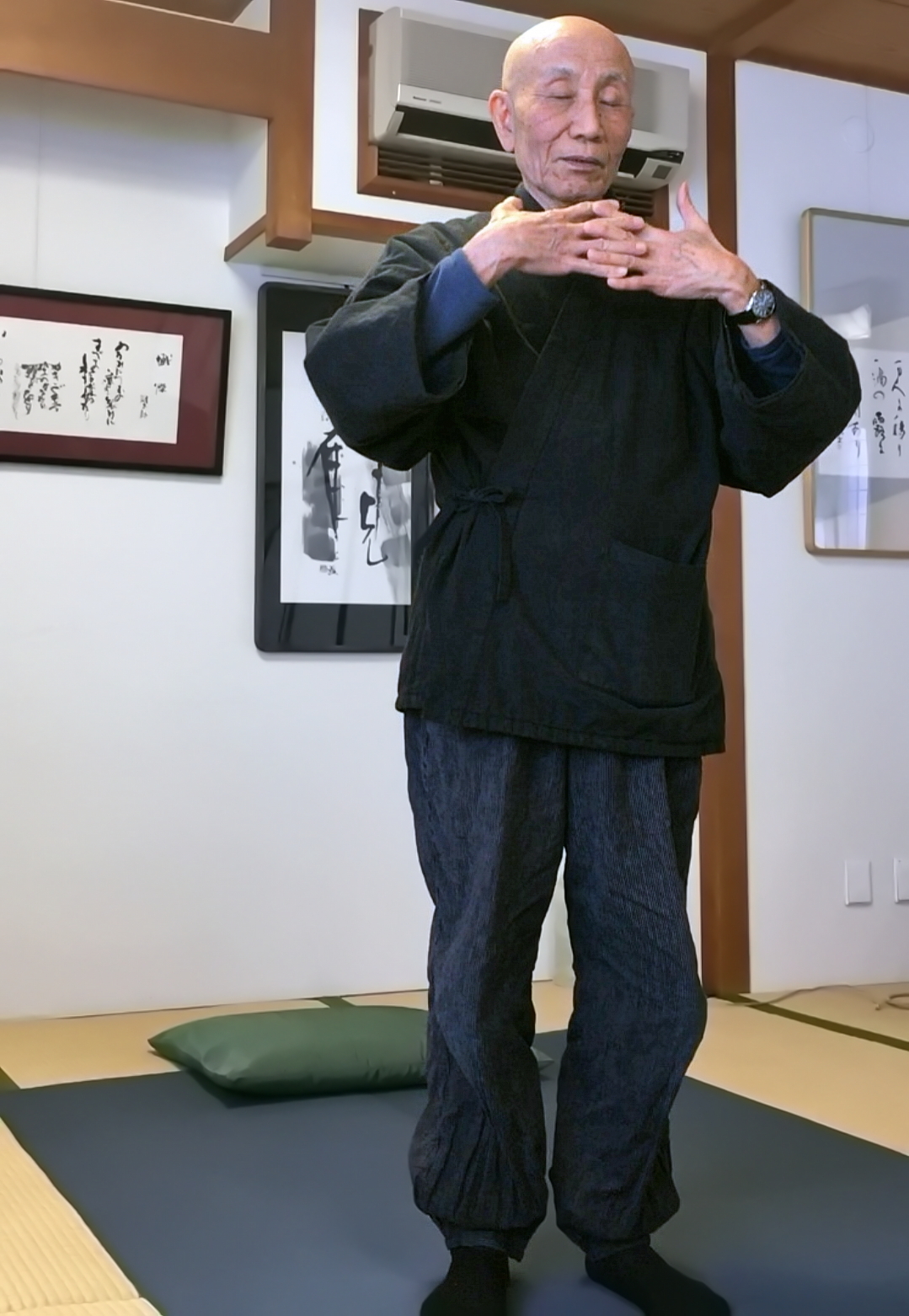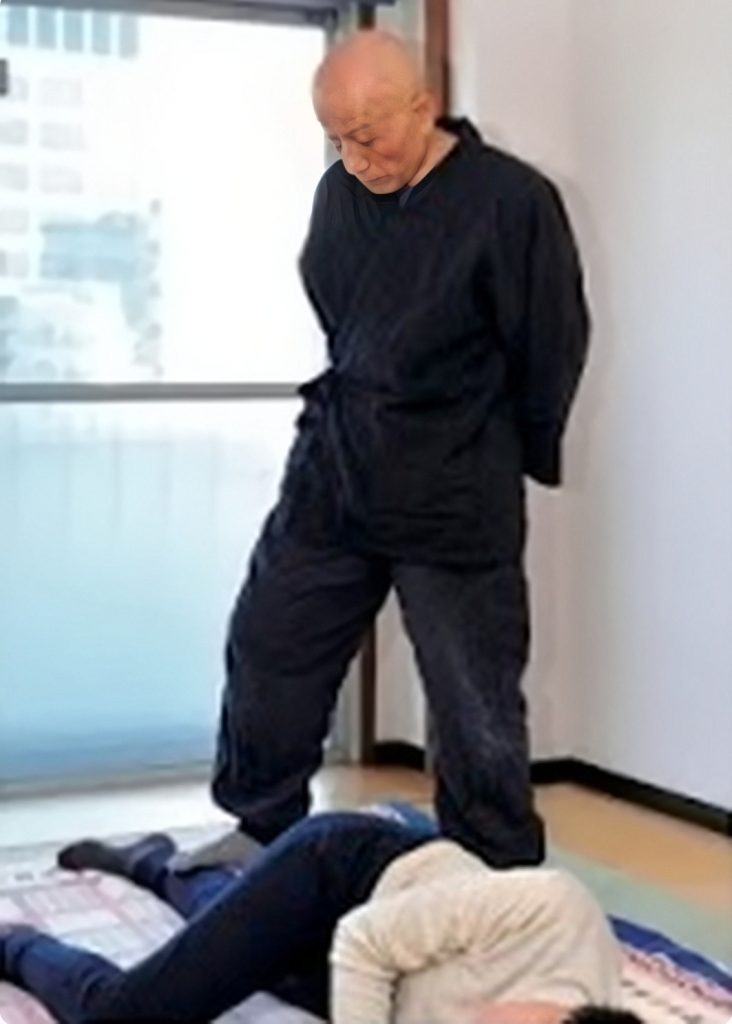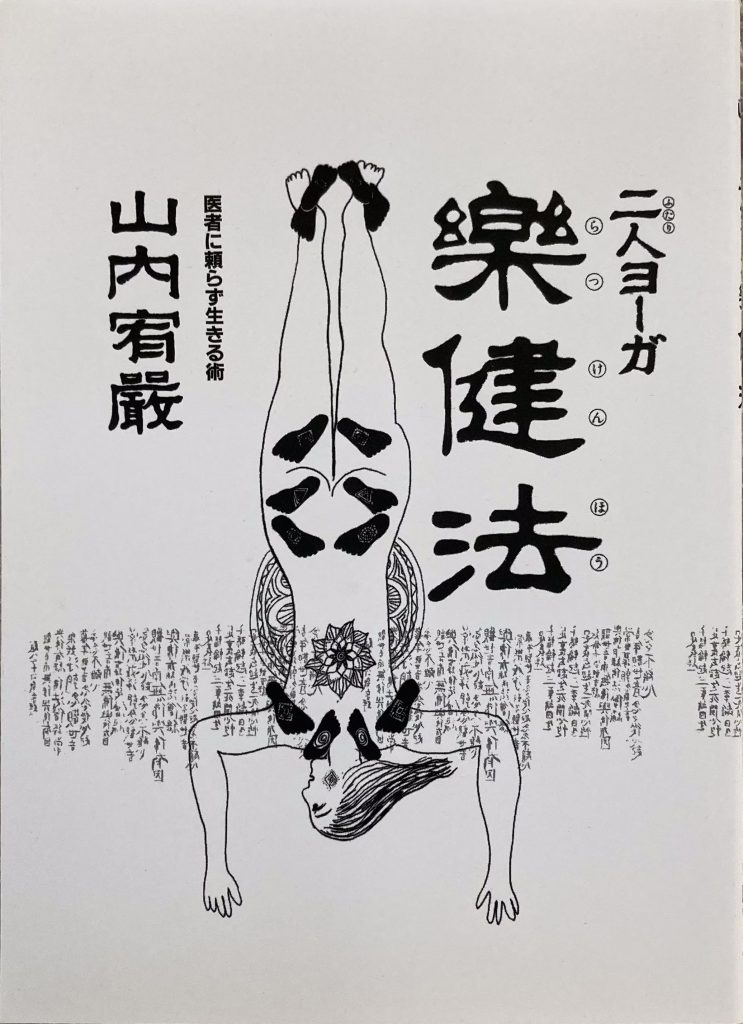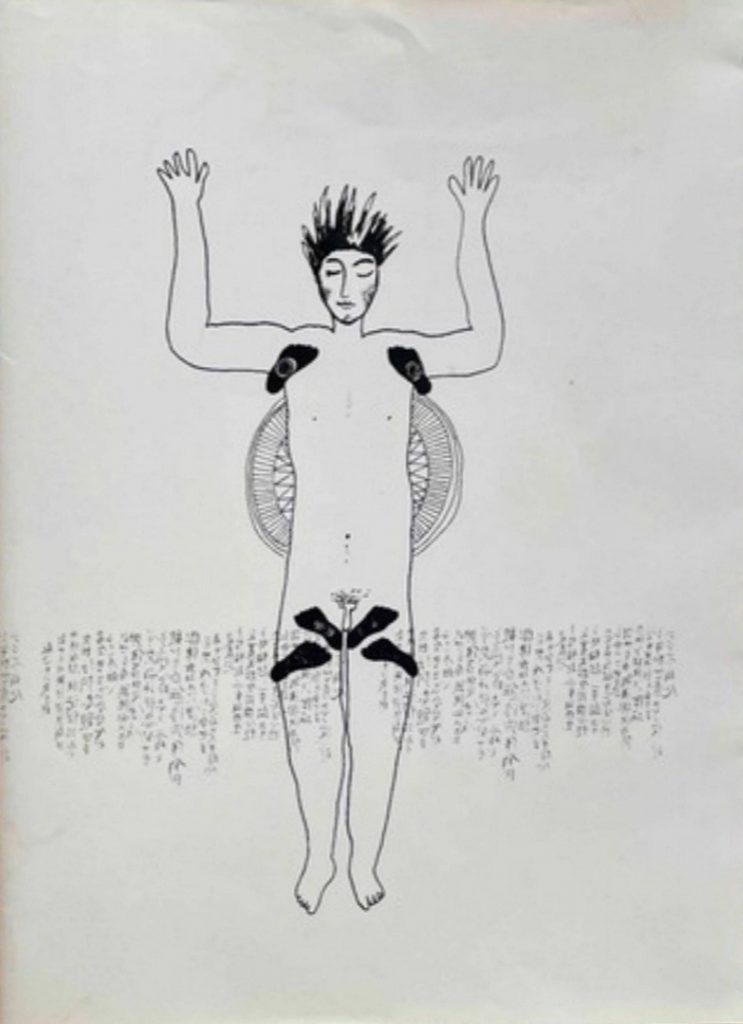Rakkenhō 楽健法
"Easy Health Method" Developed by Yamauchi Yūgen
Development of Rakkenhō
Rakkenhō 楽健法 was created by Yamauchi Yūgen 山内宥厳, a priest from the Shingon Esoteric Buddhist tradition. He was also a master baker, artist, writer, and teacher of life. Yamauchi Sensei lived at the Tōkōji Temple 東光寺 in Nara, Japan, where he ran his Rakkenhō Headquarters Dojo and taught many people his therapy. Rakkenhō is heavily influenced by the medical and spiritual teachings of Ayurveda from India.
Yamauchi Sensei for a time studied with Miyahara Kazuo 宮原一男 and learned his methods of Enmeigaku 延命学 (life extension science). One of the treatment practices he learned was how to walk on a patient with the aid of a bar to hold onto. Yamauchi Sensei removed the use of the bar and named his own art Futari Yōga Rakkenhō 二人ヨーガ楽健法. The codification of the Fumi Kata 踏み方 (Stepping Forms) treatment method and the sutra style text below was developed into a system by Yamauchi Sensei to be a way of living without relying on doctors.
Yamauchi Sensei also founded a form of natural fermentation bread making using vegetable yeast known as Tennen Kōbo Pan 天然酵母パン (Natural Yeast Bread). His mission was to help people become happy and healthy, both physically and mentally.
Yamauchi Sensei traveled to St. Etienne de Bolton, Quebec to take initiation into Kriya Yoga from my teacher during an international gathering held at the ashram. This is where I first met Yamauchi Sensei and learned his method of Rakkenhō. In the evenings after our Kriya Yoga training, Yamauchi Sensei taught me Rakkenhō by practicing his therapy on me first. I then had to get up and practice back on him what he had just shown me. We trained in this “Futari-Yoga” (yoga for two) manner for the entire international gathering together. I will never forget my time with him and the wonderful life gift he shared with me.

Yamauchi Sensei served as the secretary general of the Japan Ayurveda Society for a total of 20 years. From around 1970, he worked to spread his Rakkenho treatment method and use of natural yeast bread.
“Rakkenhō is one of the easiest ways to purify the body, to restore the body’s energy flow, to heal diseases caused by spiritual poison, and to recover from accumulated fatigue. When you practice Rakkenhō, you must always start with the left side of the body, and after that the right side.”

Foreword by Yamauchi Sensei
This Rakkenho Sutra is not a sutra of Esoteric Buddhism from ancient India, but a text I wrote myself based on teachings from Ayur Veda. Rakkenho is an altruistic Yoga, which I call Futari-Yoga (Yoga for two). The giver, uniting his breath with the receiver, presses slowly and gently with the sole of one foot the body of the other person in such a way that the receiver doesn’t feel much pain. When finished, giver and receiver exchange roles. The human warmth and kinship in doing so opens each other’s hearts. Thus, may communication among family members become lively — the lack of which is a current social problem. Through the application of Rakkenho, chronic diseases and mental illnesses disappear and health returns even before one is aware of it. Moreover, one may experience the wonder of the practice of offerings: that “to make others happy makes oneself also happy.” If we acknowledge the fact that we live from each other’s support, a sense of gratitude will never fail to well up in our hearts.
I heard thus:
One warm and pleasant spring day at a place called Yushibaka, sitting amid a multitude of Bodhisattvas, Buddha preached Rakkenho. He explained its essence and gave them an example of the practice, using Kendappa as a model: First, standing up and showing them his feet, Buddha said to them:
“Kendappa and Bodhisattvas! What do you think the soles of my feet and yours are? Is it only the ground that our feet come into contact with? “If you think our feet are used only to walk on the ground, then even if you follow a way, you will never know the Way, the dharmic truth. The Way connects not only places, but also human hearts and the essences of all living beings. If you want to follow the Way, you need a healthy body, and especially strong feet. Without this, no progress can be made. “Moreover, however strong your feet may be and however healthy your body may be, in order to go to save living beings in the distance across fields of hardship, you also need a healthy mind, a loving heart and the aspiration to learn at any moment from those you would save. Only in this way will you have truly strong feet. There will be light in your feet when you have both the aspiration to learn Rakkenho and the loving heart for all living beings. Then your feet will shine and turn darkness into light. “Those who practice Rakkenho are called Shining Rakken Bodhisattvas. Whether you go to the east, the west, the south or the north, everywhere many people will gather for your shining feet. Some may be rich, many others poor. Some may be healthy and strong, others sick and weak. There may be people nearly dying who will still ask for the help of Shining Rakken Bodhisattvas. “Bodhisattvas! When we meet these people, how do we offer them light? Just by teaching the truth, can we save people who suffer from mental or physical illness? Alas, it may be too difficult to save them only by the word of truth. Bodhisattvas! You must experience and understand my teachings with the spiritual eye and save all living beings!”
Thus Buddha preached:
Then he called Kendappa, and had him lie on the Rakken Mandala. Kendappa, lying on his side with his head to the north, his left leg straight, his right leg bent, greeted Buddha by bringing his palms together. Next, the fragrance of Heaven and the music of Heaven spread all over. Buddha stood at Kendappa’s feet, nodded with a smile, and said, “Now I will transmit Rakkenho:
“There are many people suffering from incurable diseases who grieve and ask what karma from a past life causes me such suffering? But most of the diseases are caused by ignorance of the spiritual life, by being unaware of the true self and the lack of reflection on one’s own self, and by ignorance of diet. There are many healing methods, such as hand-healing, diet-therapy, fasting, Ayur-Veda and so on. Though each of them has much effect, much effort is necessary to apply them, and it may be difficult to cut the roots of disease. In our country, Yoga has been transmitted since ancient times. Yoga is a self-help method – but some people are too sick to help themselves. “Rakkenho is one of the best and easiest ways to purify the body, to restore the body energy flow, to heal diseases caused by spiritual poison, and to recover from accumulated fatigue,” Buddha continued. “When you practice Rakkenho, you must always start with the left side of the body, and after that the right side.”
Teiyo 羝羊
Buddha began to press Kendappa on the root of the thigh with his honorable large left foot. Whereupon Buddha’s foot radiated light, and as that light showered into the eyes of the Bodhisattvas, their spiritual eyes opened. They found that Kendappa’s legs had been softened swiftly. The pain in Kendappa’s waist, caused by Zazen practice over a long time, was healed in a moment. Kendappa felt the sacred power of Buddha’s feet streaming into him and coursing through his body, and his eyes overflowed with tears.
Buddha said, “I call the root of the thigh I am now pressing upon Teiyo 羝羊. It is the life duct that connects the center of the body with the center of the feet. Once these parts, both left and right, are loosened, the bloodstream, the body liquid stream, begins to flow quite fluidly. He will awake spontaneously from illusion, and spiritual aspiration will well up within him.”
Gudo 愚童
Next, Buddha had Kendappa turn his upper body face-up while keeping his legs as before and pressed on the more inner part of the left Teiyo with his foot. Kendappa first felt burning pain, but strangely it turned into a comfortable sensation, as if divine energy was returning to his body. Buddha said, “I call this part Gudo 愚童. Once it is loosened, the liver and kidneys become vigorous, menstruation becomes well-ordered, the mind becomes peaceful and serene. One may have a healthy baby and be aware of the meaning of one’s own being.”
Yodo 嬰童
Next, Buddha had Kendappa turn his legs so that he was lying on his back and pressed with his foot on Kendappa’s thigh downwards from the groin to the knee. “This part is called Yodo 嬰童,” Buddha said. “If this is pressed well, the stomach may be activated well, good eyesight may be recovered and natural spirituality may well up, just as in a newborn baby who sees the world for the first time.” And as soon as Buddha finished pressing on Yodo, Kendappa saw Buddha’s honorable face much more clearly radiant than before, despite his farsightedness due to old age. And he appreciated with gratitude the wonder to meet Buddha, and to be administered Rakkenhō by him.
Yuiun 唯蘊
Next, Buddha pressed with his foot around the shoulder of Kendappa’s chest, then the root of his arm, downwards to the top of his fingers. Buddha said, “This part is called Yuiun 唯蘊. Once this is loosened, the thought may be well-connected with the deed, and various diseases of the heart and lungs may be healed easily.”
Daijo 大乗 and Batsugo 抜業
Next, Buddha had Kendappa lie face-down, and pressed with his right foot first on Kendappa’s left buttock, then downwards to around the back of the knee. Buddha said, “the buttocks are called Daijo 大乗 (the large boat/vehicle); the back parts of the thighs are called Batsugo 抜業 (nullifying karma). There are swellings at the root of all muscles. When these swellings grow, the muscles contract, the bloodstream is blocked, the body liquid stream is lessened, the part becomes cold and ultimately diseases are caused. Especially the swellings of the buttocks make the body cold. In order to heal diseases, there is nothing better than to make the duct stream fluid. This is an easy practice. Once swellings are softened and loosened, even the most difficult and chronic diseases will heal. You only must practice it sincerely.”
Kakushin 覚心
Next, Buddha pressed with his feet on both soles of Kendappa’s feet, and said, “This part is called Kakushin 覚心 (the enlightened mind). The soles of the feet may be considered a kind of brain. The more the feet are used, the more they find the way to the swellings on their own. Therefore, you must take care of them. Kakushin is a part and yet also a whole. It is a whole and yet also a part. You must consider this deeply. You should press well on Kakushin and let life energy Ki circulate well. Thus, do right effort diligently.”
Gokumu 極無
Next, Buddha pressed Kendappa on the root of the upper arm with his foot. Kendappa, as he was a tall and lean man, could not make his upper arms touch the carpet. Buddha said, “This part is called Gokumu 極無 (ultimate nothingness). Those who can’t make their upper arms touch the carpet may suffer from gastroptosis. It shows that the body is hardened and that a lot of practice is necessary. Practice Rakkenho wholeheartedly, and grasp and experience the state of oneness of body and mind.” Thus saying, Buddha pressed him lightly on Gokumu with his feet, chanting the enlightenment mantra. Kendappa’s arm became soft and loose very soon, and it could touch the carpet. The Bodhisattvas watched all this in a state of enlightenment.
Himitsu 秘密
Next, Buddha went over to Kendappa’s head and pressed with his left foot on the root of the left shoulder, his heel nearly touching the carpet. “This part is called Himitsu 秘密 (the secret). This part foretells of various diseases. The stiffness of the shoulders can signal coming diseases. Constipation can signal the coming of diseases, too. Don’t underestimate these signs. And you must try to solve the secret.”
Ichido 一道
Next, Buddha mounted onto Kendappa’s back and bringing his palms together (in Gassho), pressed the muscles on either side of his backbone, downwards from above to below. “This part is called Ichido 一道 (the one path). When a man loses the balance of the backbone and the muscles, he suffers various diseases. We arrange the whole body for the sake of harmonizing Ichido. When you touch Ichido, you may feel love, and the welling up of gratitude for the life and nurturing that Heaven and Earth have given you.”
Buddha stood up, returned to his seat, and smiled mercifully upon all the Bodhisattvas, who were wrapped in bliss as if they had received Rakkenho from Buddha as much as had Kendappa. Buddha said, “It is because one does not understand the essence of therapy that one dies young from diseases. You must understand that there is no incurable disease. The most important thing of all is which method to apply. Above all, cast away negative thoughts, and believe in possibility. Believe, and practice Rakkenho! Rakkenho is an easy practice, and it includes profound truth. It is an altruistic Yoga, a Yoga for two people. You must practice it sincerely and save all living beings with it. If you do it every day, your feet will necessarily shine brightly, and you’ll walk with light steps. Wherever you may go, you can turn this world into the Pure Heavenly land, a sea of the light of Buddha. Those who are given this Rakkenho will be healed and obtain peace. And those who administer it, through the practice of giving itself, will know the dharma of Buddha, and will activate blood and life energy. Both will receive benefit.”
Then Buddha said thus in a gatha, a poem:
Those who learn and practice Rakkenho can heal diseases, and can heal people, and can give them fearlessness, awareness of love. However much one may suffer from illness, if they learn and practices Rakkenho in order to heal others, they will never fail to heal themselves. Saving others turns out to be saving one’s own self. When you practice Rakkenho, you become a person of light.
楽健法 初伝 基本踏み方
Rakkenhō Shoden Kihon Fumi-Kata
(Initial Transmission Basic Stepping Forms)
Part 1
踏み方-足裏
Fumi Kata Ashiura
(How to step safely on the sole of the feet in prone position)
Part 2
踏み方-脚の三ライン(横向き)
Fumi Kata Ashi no Sanrain (Yokomuki)
(How to step on three lines of the legs in side position)
Part 3
踏み方-仰向け足の付け根, 腕
Fumi Kata Ashi no Tsukene, Ude (Aomuke)
(How to step on the inguinal region, perform basic rolling, and step on the arms in supine position)
Part 4
踏み方-うつ伏せ
Fumi Kata desu ashi, o shiri, koshi, senaka kara ude made (Utsubuse)
(How to step on the back of the legs, buttocks, hips, up the back and out the arms. Also how to press on the back with Gassho)


